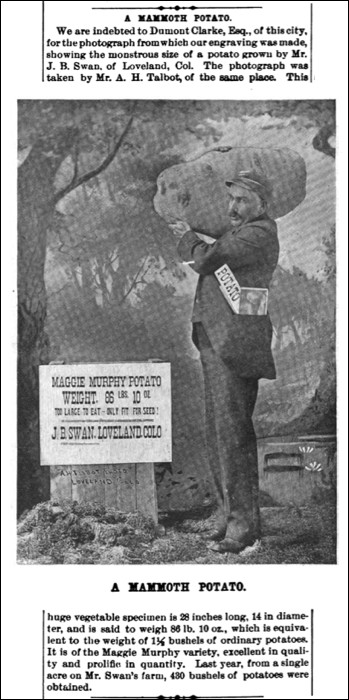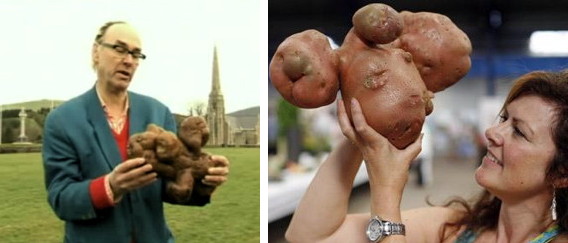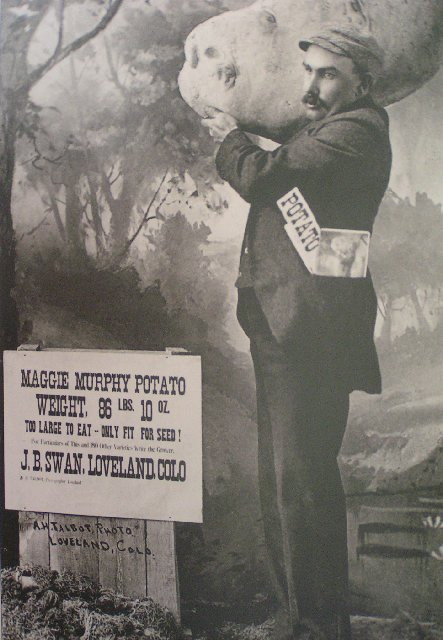Joseph B. Swan was proud of his potatoes. On his farm outside Loveland, Colorado, in the late nineteenth century, he grew 26,000 pounds of potatoes in one year on a single acre of land. He also claimed to have grown a giant potato that weighed 13lbs 8oz.
W.L. Thorndyke, editor of the
Loveland Reporter, came up with an idea to help Swan promote his spuds at an 1894 street fair. Thorndyke's idea was to create a hoax photograph of Swan showing off a truly massive potato — one as large as a boulder. He suggested Swan could pass around copies of the photo as a tongue-in-cheek advertisement.
To make the photo, Swan and Thorndyke enlisted the services of photographer Adam H. Talbot. Talbot took a photo of a potato and enlarged it to mammoth size. He then cut out a wooden board the size and shape of this enlarged image and he attached the photograph to the board. Finally, he posed Swan holding this giant faux-potato on his shoulder.
Copies of the photograph began to circulate around the community. One editor in a neighboring town thought the photo was funny, so he pinned it up on the bulletin board in his office, where it was seen by various people passing through town, many of whom asked if they could have a copy of it.
In mid-1895, a copy of the photo came into the hands of Dumont Clarke, Esq. of New York City, who promptly passed it along to the editors of
Scientific American. On the back of the photo was a note claiming the potato had been shown for a while in the office of the
Loveland Reporter, that it measured 28in in length and 14in across, and that it was equivalent in weight to 1½ bushels of ordinary potatoes.
The
Scientific American editors didn't realize the photo was fake. So they made a high-quality engraving of it (at the time it was often easier for magazines to publish engravings of photos rather than the photos themselves), and they published this engraving as a real news item in their
18 September 1895 issue, along with the information about the potato's dimensions and origin.

The Loveland potato featured in
Scientific American quickly realized its mistake and published an angry retraction several weeks later:
That Mammoth Potato
The photo. picture of the mammoth potato we published on page 199 proves to be a gross fraud, being a contrivance of the photographer who imposed upon us as well as others. An artist who lends himself to such methods of deception may be ranked as a thoroughbred knave, to be shunned by everybody.
But the damage had already been done. Word of the mammoth potato rapidly spread both nationally and internationally, causing Swan to be flooded with inquiries from people who wanted either seeds from the mammoth potato or pieces of it so they could grow their own. He also received an offer from a firm of potato growers who wanted to exhibit the potato.
Swan repeatedly explained that the photo wasn't real, but had merely been intended as an advertisement and that he thought no one would take it seriously. But eventually he grew tired of repeating this explanation, so instead he told people the potato had been stolen.
Thorndyke was reportedly more pleased with the success of the photographic fake. He boasted, "Newspapermen are reported to be the greatest liars on earth."
That wasn't the end of the mammoth potato's career. Numerous magazine and newspapers continued to repeat the claim that Swan had grown an 86lb potato, although they didn't reproduce the photo. But two years later, in 1897, the photo again appeared in print,
in The Strand magazine — once more presented to readers as a genuine photo.
The Strand, like
Scientific American earlier, soon realized its mistake and published a retraction — but, as before, the damage had already been done.
During the late twentieth century, the Loveland potato was reportedly featured on the Ripley's "Believe It or Not" television show, during the opening segment. (Though this remains unconfirmed.) More recently, Colorado playwright Rick Padden wrote a play about the incident, "The Great Loveland Potato Hoax," that premiered in 2012 at the Rialto Theater in Loveland.
Was the Loveland Potato the First Viral Fake Photo?
Today it's common for humorous or shocking fake photos, created with photoshop or other image-manipulation software, to "go viral" on the internet. By "viral," it's meant that the images spread from person to person through social networks, rather than through more centralized forms of communication such as TV or newspapers. The kind of images that go viral are usually those that the traditional media wouldn't deem important enough to pay attention to — until millions of people have seen them, at which point they become newsworthy. Famous examples of viral images include
Snowball the Monster Cat, the
helicopter-attacking shark, and
Touristguy.
The viral effect is greatly facilitated by the internet, which makes it easy for people to share information and photos. But, of course, information circulated via social networks before the internet. It just happened more slowly.
The Loveland potato photo is an example of this. It certainly was a fake photo that went viral. Which is to say that people, of their own accord, shared it with friends and acquaintances, until eventually the photo came to the attention of the print media, at which point it became international news.
But was the Loveland photo the first viral fake photo? It very well could be. In fact, it might be the first viral photo, real or fake.
Louis Daguerre announced his invention of a photographic process in 1839. Photographs made using his process, called daguerrotypes, became popular almost overnight. But it was very difficult to reproduce daguerrotypes, which meant that it was just about impossible for a daguerrotype to go viral.
In the 1860s, daguerrotyping was eclipsed by processes that did allow for photographs to be easily reproduced. However, photographs remained relatively expensive, and they tended to be reserved for serious subjects such as news reporting (particularly war coverage) and photos of loved ones.
It wasn't until the 1890s, as the cost of photography came down and new technologies allowed magazines and newspapers to print photos, that a lighter tone emerged. Photographers started creating what they called "freak photographs." By this they meant the use of photographic tricks to create humorous or absurd photographs showing impossible scenes. Favorite subjects were oversized farm and dairy products, such as corn as big as trees and cabbages larger than barns.

A typical 'freak' postcard
Serious photographers looked down their noses at this photographic frivolity, but freak photographs proved enormously popular with the public. And when photographers started printing these freak photos on postcards and selling them (around 1895), they proved to be an enormous commercial success as well, making some photographers very rich.
Freak photographs triggered a viral sharing effect far more than serious photographs did because the freak photos were visual jokes, and people like to share jokes. Which is why they were popular as postcards.
However, most of the early freak photos were obviously fake. They didn't fool anyone. Captions written on the photos, such as "We grow 'em big here!", often further identified the images as jokes.
The Loveland potato photo, on the other hand, was unusual in that it was somewhat believable. Or, at least, it wasn't obviously fake. Also, it made a specific claim and identified a person by name, further enhancing its credibility. So it aroused curiosity as well as laughter, which prompted far more people to share it with others. As a result, the Loveland potato fully went viral, whereas other freak photos didn't. It appears to be the first photo to have ever gone viral in this fashion.
What is the Largest Potato Ever?
Nigel Kermode of the Isle of Man long held the record for growing the biggest potato. It weighed 7lbs 13oz. But in 2010 the record was challenged by a potato weighing 8lbs 4oz, grown by Peter Glazebrook of Northampton.
As can be seen, these real record-breaking potatoes are a far cry from the 86lb Loveland potato.

(left)Nigel Kermode with potato; (right) A model shows Peter Glazebrook's potato
References (in chronological order)
- Robb, T.P. "The West as Seen by a Preacher," Morning Sun News, Iowa. (July 4, 1895).
- Scientific American (Sep 18, 1895). "A Mammoth Potato"
- Hawaiian Planters' Monthly (Feb 1896).
- The Strand Magazine (July 1897). The Biggest Potato On Record
- Hall, Lois. (Mar 2011). "Now That Was a Big Potato." The Senior Voice: 6.
- Jessen, Kenneth (Feb 28, 2012). "Loveland playwright Rick Padden explores a potato hoax." Reporter Herald.
- The Moon Theater. The Great Loveland Potato Hoax.
- Chilcoat, Lynette. (May 10, 2012). "Hot potato hoax hits Rialto Theater stage." Reporter Herald.






Comments
Also, bonsaikitten.com is not registered by ThinkGeek, the owner is still the spammer, but by linking to ThinkGeek most of the time, they get people to use their shortcut, that they can then subvert.